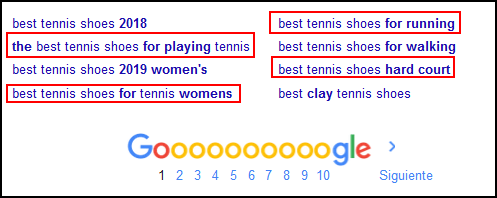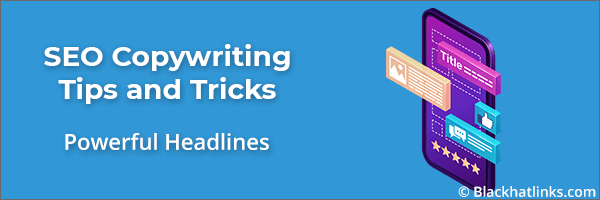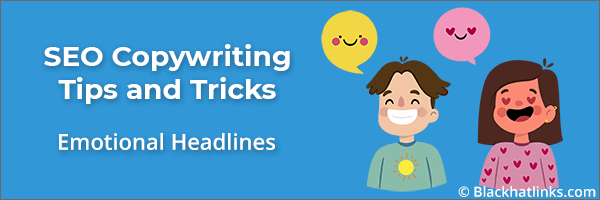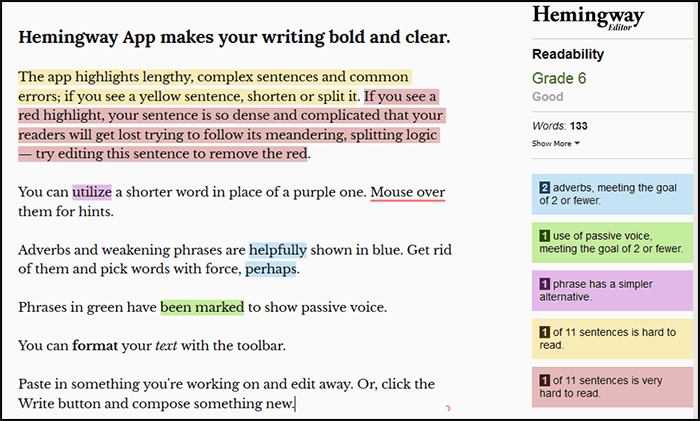12 AMAZING SEO Copywriting Tips and Tricks
12 AMAZING SEO Copywriting Tips and Tricks

SEO Copywriting is an essential skill all businesses need in their arsenal.
So many SEOs are obsessed with writing to search engine bots. They over-optimize their content and forget the main goal:
Creating content that their audience loves.
Today, we’re going to teach you how to do both. These guidelines will help you create engaging content that both ranks well in Google and boosts your conversions month after month.
Let’s begin!
What is SEO Copywriting

Copywriting is all about persuading, informing or inspiring others to take action. Needless to say, it’s impossible to do any of these things without fully understanding your audience.
Immersing yourself in your customer’s mentality, what their burning needs are and how your products and services can help them is essential to the craft.
Once you’re able to do that, all you need is a solid sentence structure and tons of practice.
SEO Copywriting is all about performing the essential tasks a copywriter would do while complying with search engine optimization parameters that allow you to rank for specific keywords.
An excellent SEO Copywriter can help you:
- Get to the top of google search results,
- Channel more organic traffic to your website,
- Improve your engagement metrics and leads and,
- Skyrocket your product and/or services sales.
This means that a competent SEO copywriting service will improve every single written piece of content in your marketing strategy, such as:
- Blog posts
- Outreach emails
- YouTube Video Scripts and Descriptions
- Podcasts Scripts and Interviews
- Facebook posts
- Press releases
- Social Media publications
And more.
Before we get into the advanced SEO copywriting tips, we must understand the basic keywords parameters.
SEO Copywriting and Keywords

When it comes to SEO copywriting, crafting compelling content for our audience should be the top priority.
But the fact is, we need to comply with certain parameters that:
- Helps Google understand what our content is about
- Allow us to rank for our target keywords
We do this by incorporating previously researched keywords into our written pieces.
Most SEO experts recommend that your main keyword is:
- Present in your URL
- Present in your Title Tag
- Present in your H1
And that your main keyword density is around 1-1.5% in your content.
Several SEO companies rather use TF*IDF optimization on their content, a process that we’ve reviewed in the past.
TF*IDF optimization is so popular because it allows you to include LSI keywords in your content.
LSI keywords stand for Latent Semantic Indexing keywords, and they’re basically your main keyword’s closely related words (at least in Google’s eyes).

LSI keywords are more important than ever because Google has continuously improved its algorithms to better understand context and search patterns.
Incorporating these related terms will, in turn, help you rank for additional keywords as well.
Here are some LSI keywords for the keyword “best tennis shoes”. Google suggest is an amazing source for these.

Depending on their search volume, you’ll want to include these as part of your H2 and H3 tags as well and expand on them. Google could consider your content as the go-to source for said keywords and earn you extra traffic.
Structuring your content around these keywords through headlines is another basic task you’ll need to complete on each written article you publish.
Here’s how:
SEO Copywriting: Powerful Headlines

Headlines are incredibly important, especially in our information-packed era.
We’re constantly bombarded with information and many of us don’t have time to read past a headline.
No wonder news outlets publish outrageous headlines all the time!
The challenge in SEO Copywriting is to include our target keywords on title tags while keeping them spicy and interesting!
Here are a few tips that can help you hook your audience and get more views:
User Numbers in your Headlines
Numbers are a big deal, and the more specific they are, the better.
In fact, we’re using this tip right now.
Compare these two headlines:
- SEO Copywriting Guide
- 12 AMAZING SEO Copywriting Tips and Tricks
The first option has our target keyword and matches search intent (people want to master SEO copywriting in a practical way).
But option number two has a stronger headline. It’s using odd numbers, uses a power word (more on these later) and matches search intent the same way option #1 would.
Even from an objective point of view, the data shows that headline #2 will stand a better chance of catching our audience’s attention. And it took us 15 seconds to supercharge it.
There are of course other forms of headlines such as:
- Reader Addressing
- How To Headlines, and
- Questions
But headlines with numbers just seem to completely overpower the rest. Probably because they appeal to the logical side of our brain.
Don’t get overly analytical just yet though, because connecting with emotions is another great SEO copywriting headline boosting technique you’d do well to use!
Emotional Headlines

Connecting with your target audience’s emotions is a marketing principle. Applying it to your headlines through the use of “power words” is no doubt a smart move.
Here are some of our favorite ones:
- New
- Crazy
- Free
- Fast
- Soaring
- Jaw-Dropping
- Amazing
Adding one of these power words to your headlines is an excellent way to spark your audience’s interest and improve clickthrough rates across the board.
Another excellent way to get your prospect’s attention is by appealing to their scarcity mentality.
Limited Time Headlines

Ever felt like you’re about to miss out on a game-changing opportunity if you don’t act quickly?
It can be especially heartbreaking even when there’s no money involved.
This is why the “you snooze you lose” angle is everywhere in sales.
Some of the most common headline superchargers are:
- Sales ends on April 15th
- Limited quantities
- Limited time offer
- Only 5 left
- Don’t miss out
These sorts of headlines are most effective on landing pages, call to actions and e-mail marketing campaigns.
Small disclaimer: use these strategically. You’re appealing to your audience’s scarcity mentality and if you continuously have 50% off sales, you’ll run your finances to the ground and tire your customers.
They might even think your products are just … Not good.
Else, why have year-long discounts on them?
Let’s continue with content structuring.
The AIDA Formula

An amazing way to structure your blog posts, newsletter emails and landing pages is with the AIDA formula.
The AIDA formula has been around for quite some time, and it works just as well today.
AIDA stands for:
- Attention: grabbing the audience’s attention
- Interest: pitch interesting data or make a bold promise to pique their interest
- Desire: address their burning need directly, appeal to emotions
- Action: lead them to the next step, it could be a conversion or simply to keep reading what you have to say.
You can structure entire blog posts around AIDA, (simply by repeating the formula on every section), or you can speak to your subscribers via email and pitch them a product.
Having a standardized formula you can follow to increase conversions is great.
But when it comes to SEO copywriting there’s a very important Google Analytics metric you need to track and improve: session time.
Improving Session/Dwell Time

Your audience’s session time, also known as dwell time, basically tells you how interesting your content is.
Google is all about offering the best possible results for a given query, and if you don’t measure up, your rankings will drop.
This is why we want you to have some guidelines that can make each piece of content super engaging and easy to interact with.
Let’s start with content formatting!
SEO Copywriting: Content Formatting
When it comes to boosting dwell time, you’ll want your content to be readable.
Paragraphs need to be very short, anywhere between 1-3 sentences long, and each sentence should have 12 to 20 words.
Studies show that content written with this format maximizes comprehension and engagement.
Short sentences are easy to read and comprehend because they act as tiny bits of information that your readers can quickly digest and move on.
Addressing your readers the right way is equally important. Here’s how:
Address your Audience Directly

Generic content is boring.
Saying that “Many struggle to grasp SEO copywriting. They’ve tried paid courses. But it doesn’t work”
Is pretty dull. By properly addressing our audience, we can make this small sentence a lot better.
Let’s try again:
“If you’re here, then you’re probably struggling with your SEO copywriting. You might’ve even bought an e-book with all sorts of copywriting tricks. And they didn’t work.
That ends today.
Put your wallet away because we’re here to give you practical, SEO copywriting tips that actually work!
Here’s our first tip: (…)”
Isn’t that better?
You’re writing to someone else that needs your products and services. They’re real people with real problems.
Acknowledge them at all times! Use their language, connect with their emotions (frustration, anger, hope) and be genuine.
Trust us, you’ll notice results very quickly once you do.
Let’s move on to another hot topic: improving your content readability score.
High Readability Score

Ever heard of the KISS principle?
It stands for, “Keep It Simple, Stupid!”
This means that you don’t get a cookie for using big words.
Your readers want your knowledge and they want it fast and easy to read.
Here are some examples:
- Replace “Utilize” with “Use”.
- Don’t use “Fascinating”, just say it’s “Interesting”.
- Have an amazing product? Don’t describe it as “unapparelled”, it’s “Unique”!
You get the point.
We at blackhatlinks like to keep it simple too:
You need to rank fast, and topple your competitors while your niche is relevant?
Then you need to build your domain rating with our PBN backlinks.
We’ve fulfilled over 234,000 orders as of today. And with over 24,400 satisfied customers, we’re leaders and innovators in our (very competitive) industry.
Our staple is offering each of our clients’ safe links that stand the test of time and get them on the highway to success.
But if you’ve already tried our services and just need a tool that helps you remove unnecessary wordiness and complicated words, then we recommend Hemingway.

Paste your written content and let the app do the heavy lifting. We promise your article will be considerably cleaner and easier to read after it’s done!
Let’s continue with social proof.
Include Social Proof
Social proof, also known as testimonials, can push your prospects from the “interest” phase, straight to the “action” phase in your sales funnel.
They’re one of the top sales weapons today. They’re so good that SEO copywriters make entire articles out of testimonials.
They’re called case studies.

Brian Dean explains how to get the most out of every testimonial that you have:
Consider that your product marked a before and after in your customers’ life.
Start with the before:
“Before I hired Dan’s pest control service, I had roaches and all sorts of bugs in my kitchen.
I tried getting rid of them myself, but it was too late: they had taken over my property.”
Follow up with the after:
“That’s when I decided to call Dan’s pest control.
He answered my phone call and dropped by within an hour. He was fast and ruthless: the bugs didn’t even know what hit them”
And finally, how they’d recommend your business:
“If your kitchen is crawling with bugs and messing with your children and pets, then I can’t recommend Dan’s pest control enough. My house is finally my own and the bugs are gone!”
This is an incredibly powerful testimonial. It’s written in story format, sounds genuine and speaks to your prospect’s burning needs and fears.
Once you start raking in your social proof, then you’d do well to plug them in at any chance you get.
Final Words
As a parting tip, consider using tools such as Grammarly, Wordable or Hemingway to clean up your content’s grammar and overall readability score.
Use plenty of imagery and never forget to include your Call To Actions using the guidelines we’ve covered in this guide.
Also, if you haven’t already check out the How to Get to the Top of Google Search Results post as well! There are some extra tips regarding content creation you’d do well to follow.
As always, thanks for reading!




Comments (1)
Very nice article!
18. July 2024, 9:25